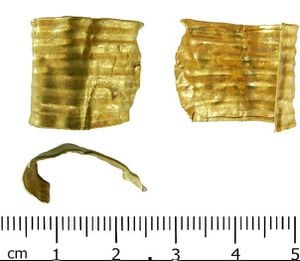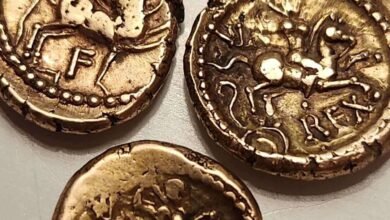After a gold nugget worth £30,000 was discovered in Shropshire, we investigate five other incredible treasure finds in the county
Over the years, the Shropshire countryside has proven to be a rich hunting ground for enthusiasts looking for a piece of history.
These are just five of the breathtaking and incredible finds that have been revealed in recent years.
Take a careful look at it
In 2016, treasure hunters in Wem found “one of the most important finds from the Bronze Age in the district”.
The item, a gold bead, is said to be around 4,000 years old.
Peter Reavill, Shropshire’s finds liaison officer at the time, said: “The gold fragment is relatively small, but it is one of the most important Bronze Age finds discovered in Shropshire.”
“It is around 4,000 years old and was made at the start of the Bronze Age, when gold was incredibly scarce and important.
“Archaeologists call this period the Chalcolithic and it was during this time that people first began working with gold, copper and tin.
“The original owner would have been a very important person within the community and the find may have been passed on before it was deposited.”
“All we have is this tiny fragment, and it is possible that it was lost after being damaged. It is much more likely that it was intentionally buried under a round mound as a grave offering in a ‘Beaker Burial.’
“The mound was later plowed up through centuries of cultivation and all that remains of the grave is this small gift.”

Historic silver find receives seal of quality
In 2017, a stunning 13th century medieval silver seal was once again found by a treasure hunter using a metal detector.
The seal, used to seal, authenticate and authenticate documents, was found on farmland near Wrockwardine.
The item had a handle on the back and a well-cut, detailed design on the front.
The central motif showed a shrine of the breastfeeding Madonna and Child, with a clergyman praying at the base.
She wears a hood or veil and wears a traditional long robe with a sash tied around the waist.
The scene is set beneath a Gothic canopy arch supporting a roof topped with carved decorations.
Below, the cleric is depicted with his head tilted upward, as if looking toward the shrine. His hands are closed in prayer.
The inscription consists of well-cut, clean medieval letters and reads: “SECRTV ROG’ D’ VEILOREAVE CLERI’ NR”, which can be interpreted as a secret or counterseal of Roger of Veiloreave – clerk.
The form of the name Veiloreave is unusual and it has been suggested that it is a place name translated from Welsh.
The term clerk is derived from cleric. The role of a clergyman in the 13th and 14th centuries included various administrative tasks in medieval courts, where he was tasked with keeping records since most laypeople were illiterate.
A clergyman could also be a clergyman. The religious nature of the piece suggests that this clerk was also a priest.



